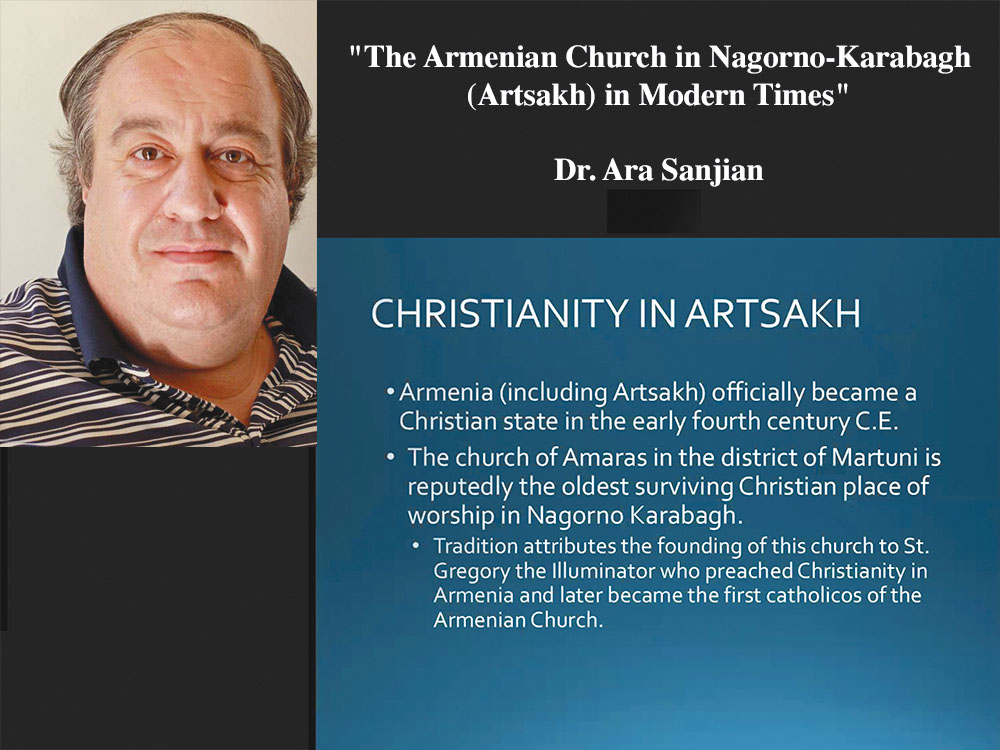
Michael Mazman
Staff Writer
Dr. Ara Sanjian, Associate Professor of History and Director of the Armenian Research Center at the University of Michigan, Dearborn, delivered a presentation on Thursday, May 6, 2021, entitled “The Armenian Church in Nagorno-Karabagh (Artsakh) in Modern Times.” The primary focus of his lecture was to discuss the structures and activities of the Armenian Apostolic church on the territory of Nagorno-Karabagh in the modern era.
Dr. Sanjian opened the discussion by introducing his audience to the Amaras Monastery, which is the first and oldest surviving Armenian church in Artsakh. He cited the Armenians’ early adoption of Christianity in 301 A.D. and the creation of the Armenian alphabet in 405 A.D. as historical points of reference to date the construction of the Amaras Monastery.
“It was during this period that St. Mesrop Mashtots created the Armenian alphabet,” stated Dr. Sanjian. “According to Armenian tradition, one of the first schools that he established to teach the new alphabet was in Amaras.”
Clearly, the Armenians have a long-standing presence in Artsakh that is associated with a deep foundation in the Christian faith. This presence has remained strong even in the face of religious persecution and violence, such as the 2020 Artsakh War.
Dr. Sanjian estimated that “Artsakh had a population of almost 90% Armenians and 10% Azerbaijanis” in 1923 when the Soviet government established Nagorno-Karabagh as an autonomous unit within Azerbaijan. This designation as an autonomous region meant that Nagorno-Karabagh had a degree of sovereignty and self-governance, while still being within the territory of Soviet Azerbaijan.
During this period of 1921-1991, the Armenian church in Artsakh was heavily persecuted by Bolshevik authorities and local leaders alike. Sanjian detailed the plight of the Armenian clergy during this time. “They put a lot of pressure on the clergy by mocking them on the street, imposing higher tax rates, excluding them from the distribution of farmland, and forcing them to publicly renounce their callings as Christians.” In some instances, church buildings were confiscated and destroyed or turned into theaters, clubs, workshops, and warehouses.
“As a result [of this practice], only 27 of the original 136 churches in autonomous Nagorno-Karabagh at the time of Sovietization were still functioning by 1929,” stated Dr. Sanjian.
An unfortunate example is the church of St. George in Stepanakert, the capital of Artsakh. In 1923, the church was expropriated and was eventually destroyed in the 1930s. In its place, the Stepanakert Drama Theatre was built in the 1950s.
Sadly, every Armenian church in Artsakh eventually suffered a fate similar to the church of St. George. Not a single church was still functioning by the 1930s. Given this sudden elimination of the Armenian church’s formal presence in the region, it is impressive that Christianity has survived in Artsakh until the present day.
Dr. Sanjian cited a 2003 field study by Dr. Hratch Tchilingirian to explain Christianity’s resilience among the Armenian people – even after their places of worship were taken from them. “In the absence of the Armenian Church as an institution, religious beliefs were gradually reduced to the private sphere of individual life,” stated Dr. Tchilingirian. This left family members with no choice but to learn Armenian Christian traditions by observing their elders, often in secret.
By exercising their faith on a personal level, the Armenians were able to keep Christianity alive in Artsakh, until the Soviet Union gradually started adopting more tolerant religious policies, beginning in the early 1950s.
In 1989, thanks to the Armenians’ success in the First Nagorno-Karabagh War and Mikhail Gorbachev’s reforms in the Soviet Union, the Catholicosate in Etchmiadzin formally announced the reopening of several Armenian churches and monasteries across the region. Some partially destroyed churches were reconstructed and new churches were also built.
Unfortunately, a number of these Armenian churches are currently under Azerbaijani control as a result of the 44-day Artsakh war. Dr. Sanjian affirmed that “at least one Armenian church that changed hands was completely destroyed by the Azerbaijanis” in an attempt to erase Armenia’s cultural and religious heritage from Nagorno-Karabagh.
Dr. Sanjian concluded his presentation by emphasizing that there is a real fear that this destruction will continue in the regions which are no longer under Armenian control and it is one of the major challenges that the Armenian Church is facing today.
 Hye Sharzhoom Armenian Action
Hye Sharzhoom Armenian Action